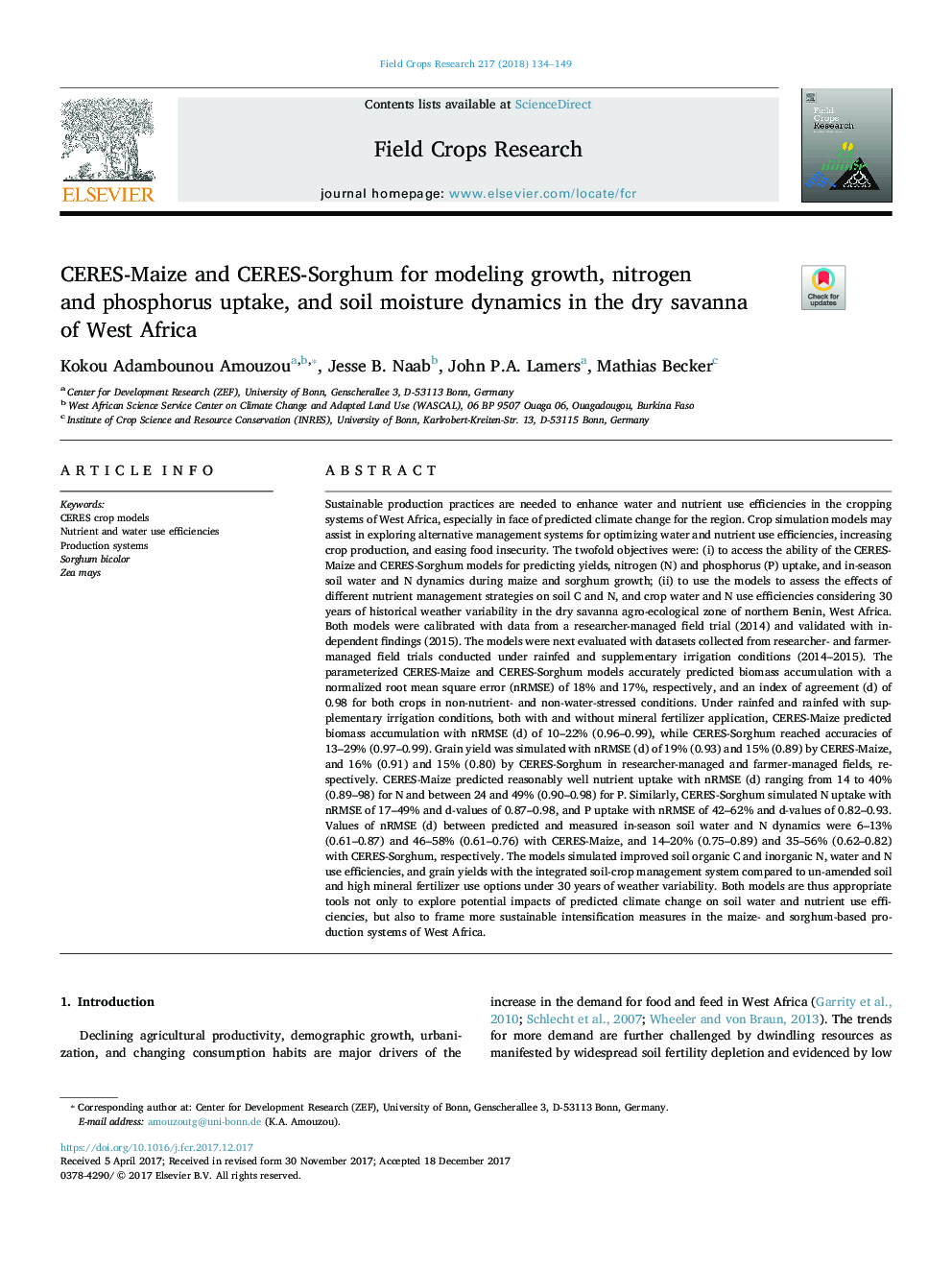| کد مقاله | کد نشریه | سال انتشار | مقاله انگلیسی | نسخه تمام متن |
|---|---|---|---|---|
| 8879400 | 1624646 | 2018 | 16 صفحه PDF | دانلود رایگان |
عنوان انگلیسی مقاله ISI
CERES-Maize and CERES-Sorghum for modeling growth, nitrogen and phosphorus uptake, and soil moisture dynamics in the dry savanna of West Africa
دانلود مقاله + سفارش ترجمه
دانلود مقاله ISI انگلیسی
رایگان برای ایرانیان
موضوعات مرتبط
علوم زیستی و بیوفناوری
علوم کشاورزی و بیولوژیک
علوم زراعت و اصلاح نباتات
پیش نمایش صفحه اول مقاله

چکیده انگلیسی
Sustainable production practices are needed to enhance water and nutrient use efficiencies in the cropping systems of West Africa, especially in face of predicted climate change for the region. Crop simulation models may assist in exploring alternative management systems for optimizing water and nutrient use efficiencies, increasing crop production, and easing food insecurity. The twofold objectives were: (i) to access the ability of the CERES-Maize and CERES-Sorghum models for predicting yields, nitrogen (N) and phosphorus (P) uptake, and in-season soil water and N dynamics during maize and sorghum growth; (ii) to use the models to assess the effects of different nutrient management strategies on soil C and N, and crop water and N use efficiencies considering 30 years of historical weather variability in the dry savanna agro-ecological zone of northern Benin, West Africa. Both models were calibrated with data from a researcher-managed field trial (2014) and validated with independent findings (2015). The models were next evaluated with datasets collected from researcher- and farmer-managed field trials conducted under rainfed and supplementary irrigation conditions (2014-2015). The parameterized CERES-Maize and CERES-Sorghum models accurately predicted biomass accumulation with a normalized root mean square error (nRMSE) of 18% and 17%, respectively, and an index of agreement (d) of 0.98 for both crops in non-nutrient- and non-water-stressed conditions. Under rainfed and rainfed with supplementary irrigation conditions, both with and without mineral fertilizer application, CERES-Maize predicted biomass accumulation with nRMSE (d) of 10-22% (0.96-0.99), while CERES-Sorghum reached accuracies of 13-29% (0.97-0.99). Grain yield was simulated with nRMSE (d) of 19% (0.93) and 15% (0.89) by CERES-Maize, and 16% (0.91) and 15% (0.80) by CERES-Sorghum in researcher-managed and farmer-managed fields, respectively. CERES-Maize predicted reasonably well nutrient uptake with nRMSE (d) ranging from 14 to 40% (0.89-98) for N and between 24 and 49% (0.90-0.98) for P. Similarly, CERES-Sorghum simulated N uptake with nRMSE of 17-49% and d-values of 0.87-0.98, and P uptake with nRMSE of 42-62% and d-values of 0.82-0.93. Values of nRMSE (d) between predicted and measured in-season soil water and N dynamics were 6-13% (0.61-0.87) and 46-58% (0.61-0.76) with CERES-Maize, and 14-20% (0.75-0.89) and 35-56% (0.62-0.82) with CERES-Sorghum, respectively. The models simulated improved soil organic C and inorganic N, water and N use efficiencies, and grain yields with the integrated soil-crop management system compared to un-amended soil and high mineral fertilizer use options under 30 years of weather variability. Both models are thus appropriate tools not only to explore potential impacts of predicted climate change on soil water and nutrient use efficiencies, but also to frame more sustainable intensification measures in the maize- and sorghum-based production systems of West Africa.
ناشر
Database: Elsevier - ScienceDirect (ساینس دایرکت)
Journal: Field Crops Research - Volume 217, March 2018, Pages 134-149
Journal: Field Crops Research - Volume 217, March 2018, Pages 134-149
نویسندگان
Kokou Adambounou Amouzou, Jesse B. Naab, John P.A. Lamers, Mathias Becker,